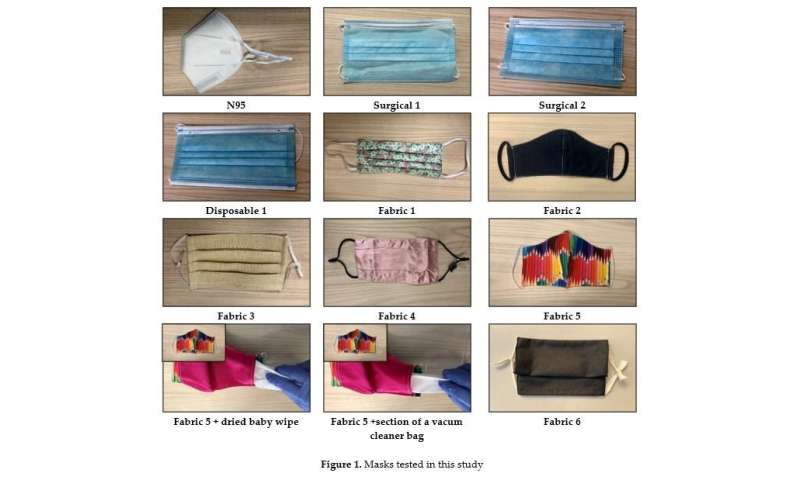Virus tests support masks against COVID-19


Testing of commonly available fabric masks has found they significantly reduce the number of aerosolised viruses a wearer could be exposed to.
The Flinders University study, published in Pathogens, found even the poorest performing mask filtered at least 50% of viruses.
The viral filtration (VFE) was calculated for two sizes of aerosols, 6 microns (VFE 6 μm) ), which is the size of aerosols produced by coughing, and 2.6 microns (VFE 2.6 μm), which are small enough to be inhaled into the lower respiratory system.
The best performing fabric masks filtered 97% to 99% of the virus numbers—at both VFE measures, with one mask performing at 98.6% (VFE 6.0 μm) and 99.1% (VFE 2.6 μm) when made according to the Victorian Department of Health and Human Services guidelines with two layers of reusable shopping bag fabric and one layer of cotton.
Another mask made from two layers of cotton had a VFE 6.0 μm of 55% and a VFE 2.6 μm of 93%. However, the effectiveness of this mask increased to become one of the best performers by simply inserting a section of vacuum cleaner bag (VFE 6.0 μm of 99.5%, VFE 2.6 μm of 98.8%) or a dried baby wipe (VFE 6.0 μm of 98.5%, VFE 2.6 μm of 97.6%).
This study also found the VFE of N95 and surgical masks supported their high advertised bacterial filtration efficiency.
While a 50% reduction might not seem particularly effective, the Flinders environmental health experts say US modeling studies have shown that if 80% of the population was wearing a 50% effective mask in areas of high transmission like New York, the number of COVID-19 deaths could fall between 17% and 45%.
https://youtube.com/watch?v=5lki7bFpozI%3Fcolor%3Dwhite
This predicted reduction in deaths is significantly increased by wearing masks in areas with lower transmission rates, the Flinders researchers say.
“This study gives useful guidance for people who are required to wear face masks in public during the COVID-19 pandemic,” says Flinders University scientist Dr. Harriet Whiley.
“The information will also inform best practice for fabric face mask design to protect against respiratory diseases and reduce community-based transmission of SARS-CoV-2 (the virus that causes COVID-19).”
Co-author Associate Professor Kirstin Ross says further research is also needed to test face mask design and fitting. “Fit is very important to reduce the risk of viruses entering though gaps between your face and the mask,” Dr. Ross says. “There also should be an education campaign to inform people about how to wear fabric masks,” she says.
“It’s important to wear the mask correctly. Do not touch your mask except to take it off, and wash your mask after use in water that is hotter than 60°C with soap or laundry detergent.”
The article, “Viral filtration efficiency of fabric masks compared with surgical and N95 masks” (2020) by H Whiley, TP Keerthiratne, MA Nisar, MAF White and KE Ross has been published in Pathogens.
Source: Read Full Article